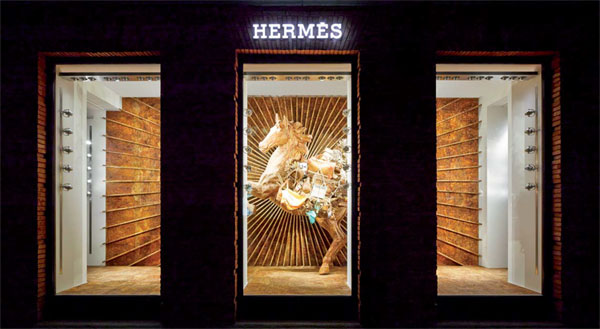Hermes brings its house style to Shanghai
|
The show window of Hermes' newly-opened store along Shanghai's historic Huahai Road. Provided to China Daily |
After six years in the making, officials from the French luxury group hope to wow Huaihai Road
Six years after Hermes, Europe's third-largest luxury goods group, broke ground on its fifth global "Maison" by renovating a heritage building on Huaihai Road in Shanghai, the store opened on Sept 12, amid much pomp and pageantry.
A phalanx of security guards and hostesses dressed in black welcomed VIPs from their limousines outside the four-story, H-shaped building.
Inside, a dozen members of the Hermes family attended what they called the "christening".
The building covers 1,174 square meters of sales and exhibition space.
"For us, it's very important that the Maison is an aesthetic statement. We believe this historic building is one of a kind," says Axel Dumas, Hermes' CEO since June last year.
"Usually a store is like a big box," he adds. "But as you can see, it's all a bit more complicated, from the staircase to everything else.
"We hope it will also develop an environment of its own," added the former banker and sixth-generation scion of the family-owned French luxury group.
The store was designed by Denis Montel of the French architectural agency RDAI, and includes a range of limited-edition products.
Hermes opened its first store in Beijing in 1997 and one in Shanghai in 2001, but some pundits have questioned whether the company, which refuses to ramp up production of its popular Kelly or Birkin bags, will maintain its exclusivity or change its business model to exploit such a vast market as China.
Hermes hires 200 craftsmen a year and it takes up to five years for each to reach peak productivity, which creates obvious production constraints, Dumas says.
"We decided in China that it is more important to have bigger stores where we can show the full range of our products.
"We have a beautiful store in Hangzhou, for example. We're going to open a store in Chengdu. But for us, Maison Shanghai is the pinnacle."
Auspiciously, given the brand's humble beginnings 177 years ago as a maker of saddles and harnesses, the opening falls in the Chinese Year of the Horse.
A Hermes fireworks-maker on horseback sits on the south side of the Maison's terracotta roof, and the brand's Chinese name, Ai Ma Shi, translates as "horse-loving gentleman".
The company's design certainly appears to be arriving at a timely moment, given that logo-free garments are gaining favor as Chinese consumers of luxury goods grow weary of the ubiquitous and flamboyant logos of brands such as Louis Vuitton, which for years have enjoyed prominence in Asia.
But rivals Louis Vuitton, Cartier and Ermenegildo Zegna, as well as luxury department stores such as Lane Crawford, have already opened stores on Huaihai Road.
"Technically, we started our work here first, but they ended up finishing theirs before us," Dumas admits, referring to the LV showroom, which winks at its arch-nemesis through a haze of LED lights from across the street. "That's Asia."
LVMH, the group that owns LV, revealed in late 2010 it had stealthily acquired a 17 percent stake in Hermes Int'l SCA. The holding later rose to 23 percent, and rumors of a planned takeover led Dumas to describe the move, speaking with London's Financial Times newspaper, as "the battle of our generation".
But Hermes seems to have won the "handbag war", at least for the time being. After losing a court battle in France, LVMH agreed earlier this month to give up most of its stake and not buy any more shares in its rival for the next five years.
This latest store differs from its other Asian Maisons - in Ginza, Tokyo and Dosan Park, Seoul - in two respects.
Both are housed in modern buildings, while the Shanghai flagship is in a century-old red-brick structure it shares with Shang Xia, the local Chinese brand Hermes launched in 2010.
Shang Xia, run by a Chinese team, has yet to make a profit, but Dumas expects it to be profitable in the long run.
Hermes enjoyed record group sales of 3.75 billion euros last year distributed evenly between the US, Asia and Europe, but has seen its bottom line dip slightly this year, despite rising revenue.
"2014 will be a little bit below, because we did not increase prices, a decision based on the yuan," adds Dumas.
The latest company figures show revenue climbed 17 percent in Asia, excluding Japan, in the first half of 2014, but specifics were not released on China.
Unlike some luxury brands and five-star hotels, Dumas says the business has not been affected by the anti-corruption campaign sweeping China, which he put down to the "very intimate" nature of Hermes' products.
"A lot of people buy Hermes for themselves, and less for gifting, even in China. That's why our growth has been maintained. We haven't been affected (by the campaign)," he adds.
Practically everything on display in the store can be ordered, or replicated, and shipped home.
That includes the sofas in the corners, the wallpaper dividing the third floor into the study and living room, and even the silver champagne glasses in the lounge bar, a room that has been designed, says the company, to better preserve the fragrance of wine.
The only exceptions are the paintings and photographs on the wall, which are owned by members of the Hermes family.
Xu Junqian contributed to this story.
matthewhodges@chinadaily.com.cn



















